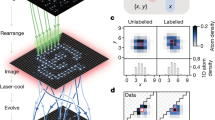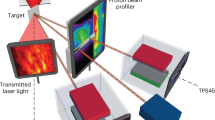Abstract
The ability to cool and manipulate atoms with light has yielded atom interferometry, precision spectroscopy, Bose–Einstein condensates and atom lasers. The extension of controlled manipulation to molecules is expected to be similarly rewarding, but molecules are not as amenable to manipulation by light owing to a far more complex energy-level spectrum. However, time-varying electric and magnetic fields have been successfully used to control the position and velocity of ions, suggesting that these schemes can also be used to manipulate neutral particles having an electric or magnetic dipole moment1,2,3,4. Although the forces exerted on neutral species are many orders of magnitude smaller than those exerted on ions, beams of neutral dipolar molecules have been successfully slowed down in a series of pulsed electric fields5,6 and subsequently loaded into an electrostatic trap7. Here we extend the scheme to include a prototype electrostatic storage ring made of a hexapole torus with a circumference of 80 cm. After injection, decelerated bunches of deuterated ammonia molecules, each containing about 106 molecules in a single quantum state and with a translational temperature of 10 mK, travel up to six times around the ring. Stochastic cooling8 might provide a means to increase the phase-space density of the stored molecules in the storage ring, and we expect this to open up new opportunities for molecular spectroscopy and studies of cold molecular collisions9,10.
This is a preview of subscription content, access via your institution
Access options
Subscribe to this journal
Receive 51 print issues and online access
$199.00 per year
only $3.90 per issue
Buy this article
- Purchase on Springer Link
- Instant access to full article PDF
Prices may be subject to local taxes which are calculated during checkout




Similar content being viewed by others
References
Kügler, K.-J., Paul, W. & Trinks, U. A magnetic storage ring for neutrons. Phys. Lett. B 72, 422–424 (1978).
Niel, L. & Rauch, H. Acceleration, deceleration and monochromatization of neutrons in time dependent magnetic fields. Z. Phys. B 74, 133–139 (1989).
Huffman, P. R. et al. Magnetic trapping of neutrons. Nature 403, 62–64 (2000).
Weinstein, J. D., deCarvalho, R., Guillet, T., Friedrich, B. & Doyle, J. M. Magnetic trapping of calcium monohydride molecules at millikelvin temperatures. Nature 395, 148–150 (1998).
Bethlem, H. L., Berden, G. & Meijer, G. Decelerating neutral dipolar molecules. Phys. Rev. Lett. 83, 1558–1561 (1999).
Bethlem, H. L., Berden, G., van Roij, A. J. A., Crompvoets, F. M. H. & Meijer, G. Trapping neutral molecules in traveling potential well. Phys. Rev. Lett. 84, 5744–5747 (2000).
Bethlem, H. L. et al. Electrostatic trapping of ammonia molecules. Nature 406, 491–494 (2000).
van der Meer, S. Stochastic damping of betatron oscillations in the ISR. CERN internal report CERN/ISR-PO/72-31 (CERN, Geneva, 1972).
Katz, D. P. A storage ring for polar molecules. J. Chem. Phys. 107, 8491–8501 (1997).
Weiner, J., Bagnato V. S., Zilio, S. & Julienne, P. S. Experiments and theory in cold and ultracold collisions. Rev. Mod. Phys. 71, 1–85 (1999).
Gupta, M. & Herschbach, D. A mechanical means to produce intense beams of slow molecules. J. Phys. Chem. A 103, 10670–10673 (1999).
Gandhi, S. R. & Bernstein, R. B. Focusing and state selection of NH3 and OCS by the electrostatic hexapole via first- and second-order Stark effects. J. Chem. Phys. 87, 6457–6467 (1987).
Lee, S. Y. Accelerator physics. (World Scientific, Singapore, 1999).
Ashfold, M. N. R., Dixon, R. N., Little, N., Stickland, R. J. & Western, C. M. The B̃′E” state of ammonia: sub-Doppler spectroscopy at vacuum ultraviolet energies. J. Chem. Phys. 89, 1754–1761 (1988).
Loesch, H. J. & Scheel, B. Molecules on Kepler orbits: an experimental study. Phys. Rev. Lett. 85, 2709–2712 (2000).
Vuletić, V. & Chu, S. Laser cooling of atoms, ions, or molecules by coherent scattering. Phys. Rev. Lett. 84, 3787–3790 (2000).
Acknowledgements
This work is part of the research programme of the Stichting voor Fundamenteel Onderzoek der Materie (FOM), which is financially supported by the Nederlandse Organisatie voor Wetenschappelijk Onderzoek (NWO). The research of R.T.J. has been made possible by a fellowship of the Royal Netherlands Academy of Arts and Sciences. We acknowledge the expert technical assistance of A.J.A. van Roij, and the help of G. Berden and J. Ye in the experiments. G. M. dedicates this work to P. Andresen.
Author information
Authors and Affiliations
Corresponding author
Rights and permissions
About this article
Cite this article
Crompvoets, F., Bethlem, H., Jongma, R. et al. A prototype storage ring for neutral molecules. Nature 411, 174–176 (2001). https://doi.org/10.1038/35075537
Received:
Accepted:
Issue Date:
DOI: https://doi.org/10.1038/35075537
This article is cited by
-
Molecular collisions: From near-cold to ultra-cold
Frontiers of Physics (2021)
-
A versatile electrostatic trap with open optical access
Frontiers of Physics (2018)
-
A novel molecular synchrotron for cold collision and EDM experiments
Scientific Reports (2016)
-
Taming molecular beams
Nature Physics (2008)
-
A molecular synchrotron
Nature Physics (2007)
Comments
By submitting a comment you agree to abide by our Terms and Community Guidelines. If you find something abusive or that does not comply with our terms or guidelines please flag it as inappropriate.



